|
Report from
Europe
EU economy yet to show any signs of acceleration
Europe‟s economy has regained a certain level of stability
since the height of the financial crisis, but growth remains
slow and there is no sign of acceleration.
The EU28 group of nations recorded only 0.4% GDP
growth in the second quarter of 2015, down from 0.5% in
the first quarter and falling short of most forecasts.
The pace of growth is particularly slow in the euro-zone
currency area which has yet to recoup output lost in the
aftermath of the financial crisis.
A particular concern is that growth remains stagnant at a
time when the region is benefiting from massive stimulus
on three fronts: a weaker euro exchange rate that typically
boosts exports, lower oil prices that raise disposable
incomes, and a bond-buying programme of more than €1
trillion (US$1.12 trillion) launched by the European
Central Bank in March this year.
The second quarter slowdown in EU growth is largely due
to France which recorded zero growth during the three
month period after 0.7% growth in the first quarter.
Although French exports are rising these have been
insufficient to offset a continuing fall in domestic
household consumption.
The French government is stepping up efforts to boost
private sector demand, having just announced an
additional €11bn in tax cuts for companies and households
over the next three years on top of €30bn in tax breaks
already promised through the government‟s so-called
responsibility pact with business. However the
government will have to cut public spending by €50
billion between 2015 and 2017 to fund the tax breaks.
Germany‟s quarterly growth rate quickened to 0.4% in the
second quarter from 0.3% in the first quarter of 2015. The
main driver of growth in Germany this year has been a rise
in exports as foreign trade received a boost from the
weaker euro. Elsewhere in the euro-zone, the Italian,
Dutch and Austrian economies all grew in the second
quarter of 2015, but just barely.
Once again there was better news from Spain where the
recovery has continued to gather pace with 1% growth in
GDP in the second quarter of 2015 following 0.9% in the
first.
Outside the euro-zone, the UK economy continues to
perform relatively well with GDP growth of 0.7% in the
second quarter of 2015, up from 0.4% in the first quarter
of the year.

Trends in GDP growth are mirrored in Eurostat‟s
Economic Confidence Indicator (ECI), a forward-looking
index that measures perceptions and expectations in five
surveyed sectors (industry, services, retail trade,
construction and consumers) in all EU Member States
(Chart 1).
After a period of strong recovery in economic sentiment in
2013 and the first half of 2014, the ECI for the EU as a
whole dipped during winter 2014/2015 and has recovered
only slowly since then.
The dip was mainly due to a sharp fall in sentiment in Italy
at a time when the UK and Germany were also sliding
from the heights achieved in mid-2014. Sentiment has
been recovering slowly in France and rapidly in Spain
over the same period.
The good news is that overall EU-wide sentiment has
remained above 100 throughout this period ¨C indicating
above average economic sentiment. This is despite widely
publicised financial problems in Greece leading to some
renewed concern about the long-term stability of the euro.
European construction activity stalls
Europe-wide, the construction industry continues to
disappoint. Although overall European construction
activity hit bottom in March 2013, it increased only slowly
until April 2014 and has been static at 5% below the 2010
level since then.
Construction activity in France has been sliding in recent
months, while Italy still remains extremely depressed.
More positively, the gains made in UK and Spanish
construction activity in 2014 have been maintained in
2015 while activity in Germany remains stable at a high
level (Chart 2).
¡¡
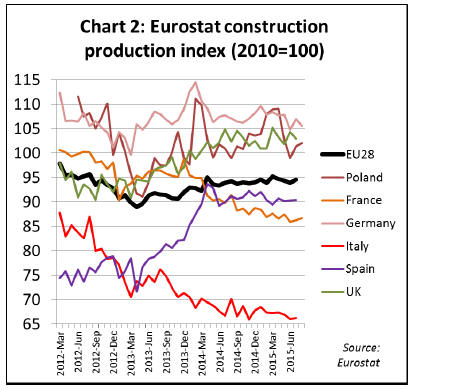
The Eurostat Construction Confidence Index in the EU
remains stagnant and deep in negative territory, indicating
that many in the industry still expect market conditions to
deteriorate rather than to improve in the next three months.
Confidence in France dipped sharply during the summer
this year.
However confidence is higher in the UK and Germany
than elsewhere in Europe. Confidence in Italy, while still
low, has been improving this year (Chart 3).
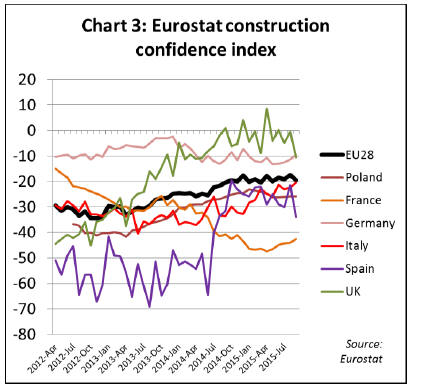
More positively, the latest EU-wide data for building
permits shows that across Europe these recorded two
consecutive quarters of growth in the first half of 2015, the
first time this has occurred for at least 5 years.
Building permits have increased this year in most main EU
markets, growing particularly rapidly in Spain and the
Netherlands (Chart 4).
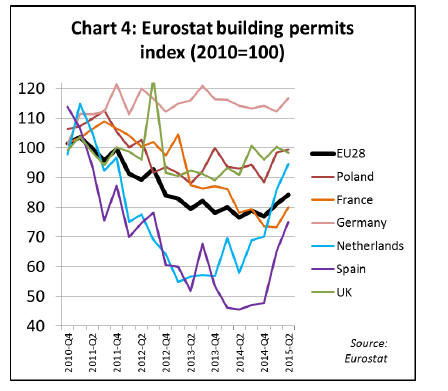
The growth in building permits, a forward looking
indicator, is reflected in forecasts which generally remain
optimistic about the prospects for sustained recovery in
European construction over the medium to long term.
A report by Building Radar, an independent research
agency, forecasts that EU-wide construction activity will
increase by 2% per annum between 2015 and 2017, and
then by around 3% per annum between 2018 and 2020.
New build growth is expected to rise to around 7.6% in
2020 while growth in renovation and maintenance will rise
more slowly to around 4.5% by 2020.
At these growth rates, the total value of EU construction
would increase from €1305 billion in 2014 to €1502
billion in 2020.
Although the value of EU construction in 2020 would still
be below the peak level just prior to the financial crises (in
excess €1600 billion in 2007 at constant prices), the sector
remains vast and generates a huge level of activity.
European wood joinery production stabilised in 2014
According to newly-published Eurostat data, the total
value of EU production of wooden doors and windows
increased slightly in 2014 after a period of decline. EU
imports of both commodities also rebounded from the low
levels recorded the previous year. However domestic
producers maintained their hugely dominant position in
these market segments.
EU wooden door production was €6.18 billion in 2014, up
1.6% compared to the previous year (Chart 5). Wooden
door production increased in Germany (+2.6% to €1370
mil.), France (+9.2% to €698 mil.), Poland (+5.4% to €398
mil.) and Spain (+6.7% to €349 mil.).
However this was offset by a fall in production in Italy (-
4.3% to €750 mil.) and in Sweden (-2.8% to €267 mil.).
Production in the UK remained stable at €844 mil.

EU wood window production increased 0.5% from €6.00
billion in 2013 to €6.03 billion in 2014 (Chart 6). During
2014 production remained stable at €1.32 billion in Italy,
the largest wood window manufacturing country.
Production fell during 2014 in Germany (-3.1% to
€840m), France (-10.7% to €546m), and the UK (-6.1% to
€425m).
However these losses were offset by rising production in
Poland (+4.9% to €574m), Denmark (+14.1% to €505m),
Austria (+4.2% to €469m), Sweden (+13.1 to €437m) and
the Netherlands (+10.7% to €206m).
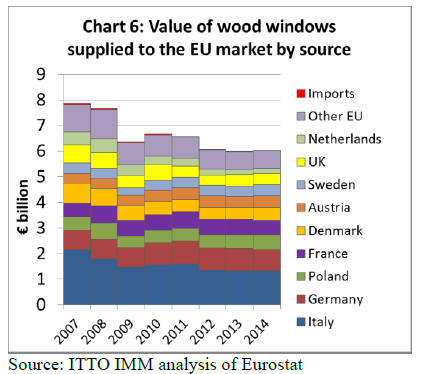
The Eurostat index of joinery production in EU countries
(which excludes flooring but includes doors, windows and
glulam and covers only a few countries) shows that
production stabilised at a low level in Italy and France in
the first half of 2015 after 5 years of continuous decline.
Production in Spain has recovered slightly this year but is
still 30% down on the 2010 level. Production in Germany,
while varying on a seasonal basis, has been relatively
stable overall during the last 5 years (Chart 7).
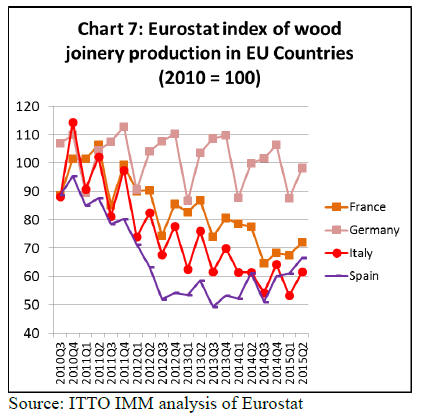
EU wood door imports rise 20% in 2015
Imports of wood doors into the EU were valued at €168m
in the first 6 months of 2015, 20% more than the same
period last year (Chart 8). Imports from China increased
24% to €56.4m, while imports from Indonesia increased
37% to €50.5m and imports from Malaysia were up 26%
at €21.1m.
Imports of wood doors from Brazil remained stable at
€9.3m during the period. Imports accounted for around
4.6% of the total supply of EU wooden door consumption
in 2015, up slightly from 4.5% in 2013 but down from 5%
in 2010.
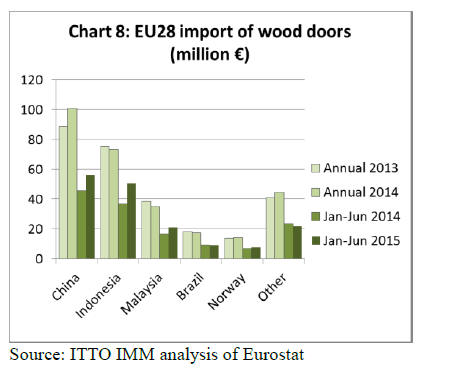
Negligible EU imports of wood windows
The EU market for wood windows is very heavily
dominated by domestic producers. In 2014, imports
accounted for only 0.4% of the total value of EU wooden
window consumption, the same as the previous year but
down from 0.8% in 2007. EU imports of wood windows in
the first six months of 2015 were valued at €15.3m, 42%
more than the same period in 2014.
Most wood windows imported into the EU derive from
other European countries, including Norway, Bosnia and
Switzerland. Imports from all these countries increased in
the first half of 2015.
However, the largest increase in imports was from the
Philippines which surged to €2m in the first half of 2015,
more than three times the value of the same period in 2014
(Chart 9).

EU glulam imports continue to rise in 2015
The EU imported 65,300m3 of glulam products in the first
half of 2015, 6% more than the same period in 2014.
Imports from Russia increased 10% to 14,600 m3 during
the period (Chart 10). There was also a 20% increase in
imports from Indonesia to 12,900 m3.
Imports from Malaysia and China were stable in the first
six months of 2015, at 11,000 m3 and 7000 m3
respectively.

Imports of glulam account for around 5% of total EU
consumption of this commodity. Much of the imported
glulam consists of laminated veneer lumber for window
manufacturing. Glulam imports from Russia and China are
primarily pine and larch. Imports from Malaysia and
Indonesia consist of meranti.
EU imports of joinery products from China rise 26%
EU28 imports of joinery products (excluding flooring)
from China had a value of €68.5 million in the first 6
months of 2015, 26% more than the same period the
previous year. Chart 14 summarises EU imports of joinery
products from China by product group and EU Member
State.
Doors make up the bulk of EU joinery trade with China,
with total value of €100.7 million in 2014. The UK and
Romania are the main European markets for China‟s
wooden doors and imports by both countries have been
rising in the last three years.
Imports of wood doors from China are also rising in
Ireland and Belgium this year. However imports by France
have declined this year after rising in 2014.
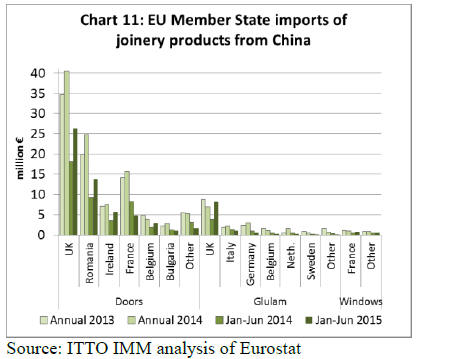
EU imports of glulam products from China were €10.7m
in the first 6 months of 2015, 36% more than the same
period in 2015. The UK is the only EU country importing
significant quantities of glulam products from China.
UK imports of Chinese glulam fell 18% last year but have
rebounded strongly in 2015, reaching €8.2 million in the
first 6 months, more than during the whole of 2014.
EU imports of finished wood windows from China
increased 35% in the first 6 months of 2015, but were still
negligible with a value of only €1.4m, mainly destined for
France.
CLT development creates new opportunities for
hardwoods
The latest UNECE Forest Products Annual Market Review
highlights the rapid growth in the market for crosslaminated
lumber (CLT) and the new opportunities the
product creates for wood, including hardwood, to compete
in high-end structural applications.
Although the first CLT production facilities were
constructed in the DACH countries (Germany, Austria and
Switzerland) in 1994, the full potential is only now being
realised following a long period of technical and market
development.
CLT first entered the building market during the 2005 to
2010 period, transforming from a small-scale niche
product into large-scale industrial production.
CLT panels consist of several layers of structural lumber
boards stacked crosswise (typically at 90 degrees) and
glued together on their wide faces and, sometimes, on the
narrow faces as well.
In special configurations, consecutive layers may be
placed in the same direction to obtain specific structural
characteristics. CLT products are usually fabricated with
three to seven layers, but with additional layers in some
cases.
Thickness of individual lumber pieces typically varies
from 16 mm to 51 mm and width varies from 60 mm to
240 mm. Boards are finger-jointed using structural
adhesive. Lumber is visually-graded or machine stressrated
and is kiln dried. Panel sizes vary by manufacturer;
typical widths are 0.6m, 1.2m, and3 m, while length can
be up to 18m and thickness up to 508 mm.
The dimensions and lay-up of CLT production are now
internationally standardized and recognised, and
production techniques are optimized in modern
manufacturing facilities. CLT is designed to maximise
yield, utilise lower grades of lumber, and it can be made in
a high volume of very large sections.
The result is a light but very strong panel product that can
be made off-site and erected quickly to form structural
walls, floors and ceilings. CLT is used in a wide range of
applications in single-family houses, multi-storey towers,
public buildings and specialty construction.
CLT offers new opportunities for wood to compete in
large-scale structural applications dominated for many
years by concrete and steel. In addition to delivering
comparable technical performance, CLT panels can
readily out-perform these alternatives on environmental
issues. Wood‟s renewability, low embodied energy, and
potential as a carbon store during use are all considerable
benefits.
Global production of CLT was about 625000 cu.m in
2014, and this figure is forecast to increase to about
700000 m3 in 2015. About 90% (560,000 cu.m) of global
cross-laminated timber (CLT) was produced in Europe in
2014, and this is forecast to increase to 630,000 cu.m in
2015. The DACH countries have continued to be the
driving force in CLT development, not only as the
originators of CLT products but also as the leading CLT
producers. Austria has seven CLT production facilities,
Germany three and Switzerland two.
Minor production sites exist in Finland, Italy, Norway,
Spain and Sweden, and more CLT factories are under
construction in Finland, France, Sweden and the UK. The
central European CLT industry is strongly export oriented,
supplying other parts of Europe as well as overseas
markets.
The use of CLT is making possible the construction of tall
wooden buildings. The current record-holder is a 14-storey
residential high-rise in Bergen, Norway, and an 18-storey
wooden building is planned in Vancouver, Canada.
Earthquake-prone countries such as Japan have shown
keen interest in increasing the use of CLT, and Japan has
published a roadmap to pave the way for CLT in the
Japanese building market.
To date commercial production of CLT has been
dominated by softwood, notably Norway spruce and Sitka
spruce, for reasons of price and wood consistency.
However the American Hardwood Export Council
(AHEC) is also now promoting development of hardwood
CLT, noting that some hardwood species are underutilised
and readily available at competitive prices while
also offering up to twice the inherent strength of
softwoods.
This last factor presents an opportunity to significantly
reduce the amount of fibre, or mass, required to achieve
the same strength performance. Hardwood species also
provide opportunities to improve the appearance of CLT
panels.
AHEC is particularly promoting the potential for CLT in
tulipwood (Liriodendron tulipifera), an abundant U.S.
hardwood species. Other temperate hardwood species with
potential include poplar and birch.
The potential for tropical hardwood CLT has yet to be
seriously explored, but there may be specific opportunities
for some faster growing plantation species or the pioneer
species found in large quantities in secondary tropical
forests.
Eucalyptus is generally considered too difficult to machine
to be a viable option for CLT, but recently progress is
being made in Australia to develop a related product under
the brand name ¡°Cross Laminated Strand Timber¡± by
Melbourne-based Lignor.
The international CLT product and design standards, and
open-source software packages such as the CLTdesigner
have supported the international trade of CLT.
Standardization in Europe comprises product standard EN
16351 (currently a draft version, with legal validity
envisaged by the end of 2015) and design standard EN
1995-1-1 (currently in revision).
For a review of the CLT market see UNECE Forest
Products Annual Market Review 2014-15:
http://www.unece.org/fileadmin/DAM/timber/publications
/2015-FPAMR.pdf
¡¡
|